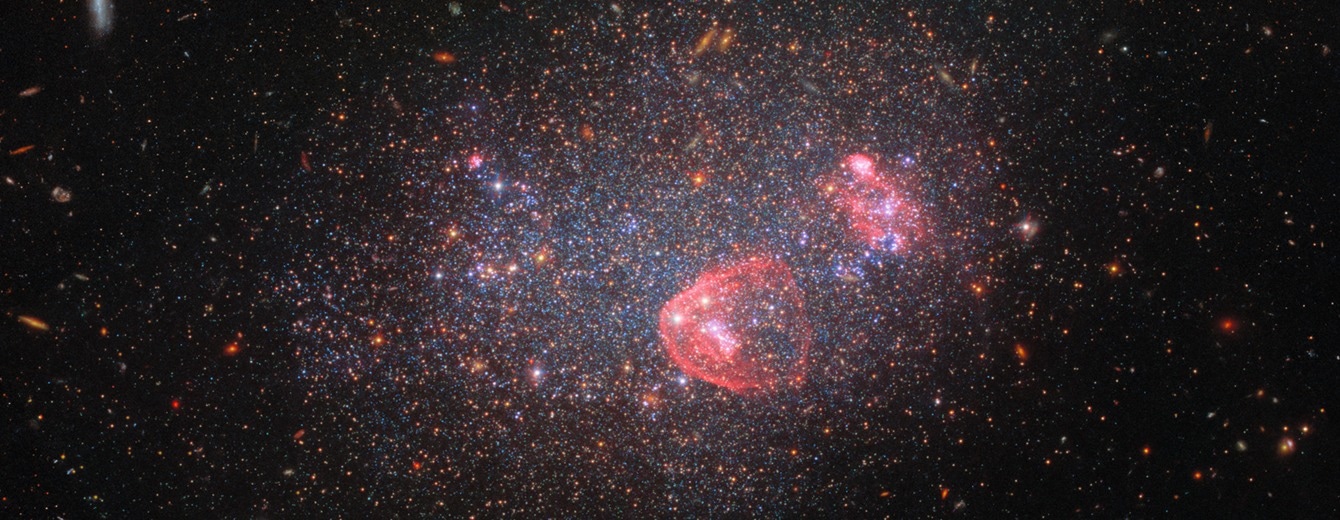Hubble’s vibrant images reveal a perpetually festive universe, with the dwarf irregular galaxy UGC 8091 serving as a splendid illustration.
 Dwarf Irregular Galaxy UGC 8091. Image Credit: Space Telescope Science Institute
Dwarf Irregular Galaxy UGC 8091. Image Credit: Space Telescope Science Institute
The intricate dance of matter and energy gives rise to vivid blue, newly formed stars resembling a celebratory string of lights. Wrapped in luminous cocoons of hot, pink hydrogen gas, this galaxy boasts a stellar population of around 1 billion stars. While this might sound impressive, it is merely 1/100th of the mature Milky Way galaxy stars.
UGC 8091, a belated arrival to the cosmic gathering, stands out amidst the early universe's abundance of dwarf galaxies that gradually fused to construct the grand spiral galaxies we observe today. Positioned 7 million light-years away, UGC 8091 has recently unveiled its dazzling tapestry, contributing its own sparkle to the cosmic spectacle.
In this festive image captured by NASA and ESA's Hubble Space Telescope, the billion stars within galaxy UGC 8091 resemble a dazzling snow globe.
Positioned approximately 7 million light-years away in the Virgo constellation, this dwarf galaxy deviates from the typical orderly spiral or elliptical appearance, classifying it as an “irregular galaxy.”
Unlike conventional galaxies, UGC 8091's stars create a radiant and intricately woven pattern reminiscent of brightly shining string lights rather than the conventional structure of a galaxy.
The irregularity in its appearance may be attributed to tumultuous internal activity or interactions with neighboring galaxies, resulting in a unique class of galaxies characterized by diverse sizes and shapes—exemplified by the diffuse scatter of stars in this particular galaxy.
This image is a composite of 12 camera filters spanning from mid-ultraviolet to the red end of the visible spectrum. The conspicuous red patches likely represent interstellar hydrogen molecules, illuminated as a result of excitation by the intense light emitted from hot, energetic stars.
In addition to these vibrant hydrogen emissions, the image showcases many glimmering spots, consisting of a mix of older stars. The backdrop unveils a captivating array of distant and diverse galaxies, captured with remarkable clarity through the sharp view of the Hubble telescope.
The data used to create this image were gathered by Hubble’s Wide Field Camera 3 and the Advanced Camera for Surveys over the period from 2006 to 2021.
The observational initiatives behind this image were designed to explore various aspects, including the investigation into the historical role of dwarf galaxies in reheating hydrogen that had cooled during the universe’s expansion following the Big Bang.
Astronomers are also delving into the composition of dwarf galaxies and their stars, aiming to unravel the evolutionary connections between these ancient galaxies and more contemporary ones, such as the Milky Way galaxy.
The Hubble Space Telescope represents a collaborative effort between NASA and the European Space Agency (ESA). NASA’s Goddard Space Flight Center, located in Greenbelt, Maryland, oversees the management of the telescope. Hubble and Webb science operations are conducted by the Space Telescope Science Institute (STScI) in Baltimore, Maryland.
Operated for NASA by the Association of Universities for Research in Astronomy, based in Washington, DC, STScI is crucial in advancing the scientific missions of both the Hubble Space Telescope and the James Webb Space Telescope.